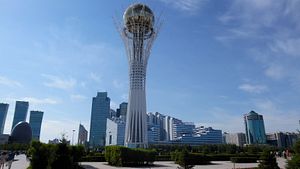On March 15, four of the five Central Asian presidents are set to meet in Astana. Billed as the first summit of Central Asian leaders in nearly a decade, the gathering holds special significance in a region which Luca Anchesci, a lecturer in Central Asian Studies at the University of Glasgow, described in The Diplomat Magazine last December as “one of the most dis-integrated and disconnected regions in the world.”
With Kazakhstan’s Nursultan Nazarbayev playing host and Uzbekistan’s Shavkat Mirziyoyev as the catalyst, the region’s two largest economies are set to revive internally focused and inspired connectivity. They’ll be joined by Tajikistan’s Emomali Rahmon and Kyrgyzstan’s Sooronbay Jeenbekov. Turkmenistan’s president, RFE/RL reported last week, will not be attending the Astana summit, but Ashgabat is dispatching the speaker of parliament, Akja Nurberdieva.
One point Anchesci made in his article honed in on the fact that despite large-scale infrastructure projects — such as the Central Asia pipeline from Turkmenistan to China — connectivity in the region has more often than not been outward-facing, or centrifugal. Grassroots connectivity, he wrote, has been systematically frustrated by the region’s political architecture and divergent policy strategies seeping out of Central Asia’s capitals.
Kazakhstan, for example, has charted a successful, internationally oriented strategy that has sought to both legitimize Nazarbayev’s continued rule and plug the country into great power networks. Kazakhstan landing a two-year nonpermanent seat on the United Nations Security Council is both a result of serious campaigning and a feature of Astana’s so-called multivector foreign policy.
But even with this global outlook and success, Kazakhstan couldn’t rope the rest of the region into the dream of connectivity. Uzbekistan, under previous leadership, “acted more often than not as a boulder in the road impeding greater cooperation across the region,” I wrote last November. Having just attended Mirziyoyev’s regional security and cooperation conference in Samarkand, I noted, “What was remarkable about Samarkand was not the conference — those are much the same all over the world — but rather the sense that this time optimistic statements about cooperation actually mark the starting point of action, rather than just the repetition of standard talking points.”
At Samarkand, the foreign ministers from Kazakhstan, Kyrgyzstan, Tajikistan, and Turkmenistan all took to the podium to speak and presumably, behind closed doors, they were discussing the possibility of a regional leaders’ meeting. The idea was repeated several times by Uzbek government speakers and others at the conference, with the stress that the goal is not some supranational organization, just a functional regional dialogue.
The time may indeed be right for the concept to succeed. Central Asia’s leaders see each other to varying extents at several regional meetings, such as the Shanghai Cooperation Organization (SCO) and the Collective Security Treaty Organization (CSTO) summits. But membership varies, for example, with Uzbekistan a member of the former but only a former member of the latter — and Turkmenistan a member of neither. The SCO and the CSTO, while including Central Asian states, are not solely focused on Central Asia’s issues. The Eurasian Economic Union includes Kazakhstan and Kyrgyzstan, along with Russia, Armenia and Belarus but hasn’t yet drawn in the rest of the region.
Central Asia doesn’t need another alphabet-soup grouping, but regular and routine conversations between the region’s leaders — without outside influence, whether it be in the form of Russia, China, or the United States — would be a positive development.
What can we expect from the summit? Smiles and handshakes, certainly. One of the most concrete outcomes would be further discussion of resurrecting Central Asia’s unified electricity grid, but an iteration of shared regional priorities would be welcome. We can guess at the list — increasing trade, water resource management, energy security, freer movement of people, and so on. It’s critical for Central Asia’s leaders to not just say the right words, but follow up with action aimed at addressing the frictions between them and seizing on the opportunities buried among them.
Check out this week’s Majlis Podcast for more on the summit.

































